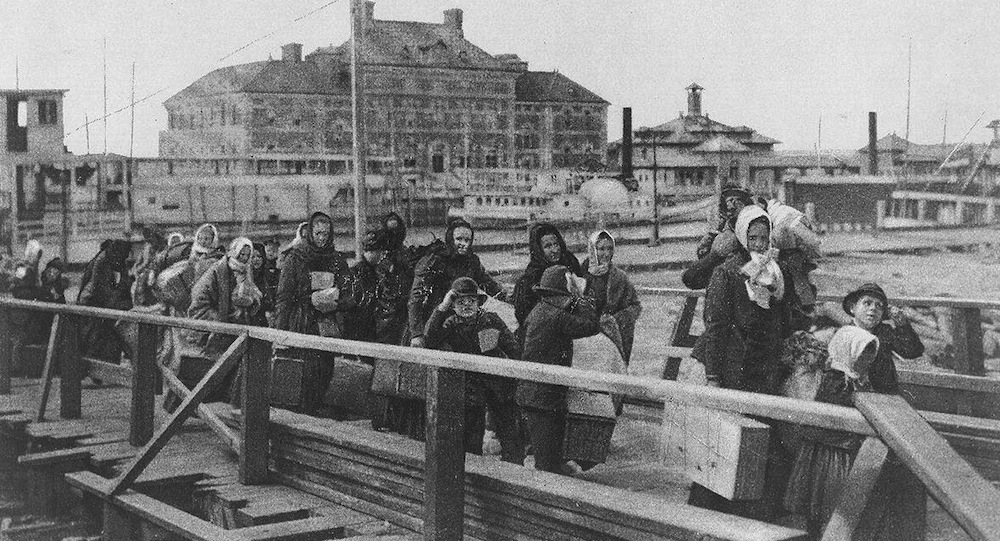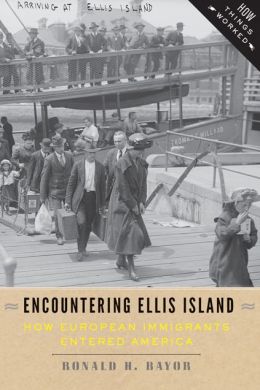
 Immigrants arrive in the U.S. today at thousands of entry points, by plane, boat, car, and foot. But for decades at the turn of the 20th century, the harbor at Ellis Island was the main gateway to America. The recently erected Statue of Liberty welcomed these huddled masses, and the hive of activity that was New York City buzzed just beyond. In the Great Hall, as immigrants awaited processing with their life’s belongings in their hands, anxious and excited voices in Italian, Polish, Ukrainian, Slovak, German, Yiddish, French, Greek, Swedish, and other languages bubbled up to the ceiling.
Immigrants arrive in the U.S. today at thousands of entry points, by plane, boat, car, and foot. But for decades at the turn of the 20th century, the harbor at Ellis Island was the main gateway to America. The recently erected Statue of Liberty welcomed these huddled masses, and the hive of activity that was New York City buzzed just beyond. In the Great Hall, as immigrants awaited processing with their life’s belongings in their hands, anxious and excited voices in Italian, Polish, Ukrainian, Slovak, German, Yiddish, French, Greek, Swedish, and other languages bubbled up to the ceiling.
The heyday of Ellis Island—1892 to 1924—is the subject of a new book by Ronald Bayor, Encountering Ellis Island: How European Immigrants Entered America. We posed five questions to Bayor, a Georgia Institute of Technology historian and former president of the Immigration and Ethnic History Society, about the essence of his book.


-
What difference did it make that immigrants came through Ellis Island versus other ports of entry to the U.S.? How important was it to the American immigrant experience that Ellis Island was the first port of call?
During the 1892-1924 period, immigrants could enter the U.S. through over 20 inspection stations, usually ports, but including the borders with Mexico and Canada. The Ellis Island station was the largest and received over 70 percent of all immigrants to the U.S. at that time. Ellis had the most extensive inspection process and the most developed hospitals. All other entry points copied the procedure established there.At Ellis Island, immigrants were immediately co-mingled with migrants from all parts of the world. The cacophony of languages and the different styles of clothes, all spoke to diversity as the immigrants crowded together on the piers, at the inspection sites, and in the detention areas.
A different experience existed for the Chinese and other Asians coming into Angel Island in San Francisco Harbor. The Chinese found a strong unwelcoming atmosphere; they were segregated from other immigrants, and saw Europeans having an easier entry or inspection experience. The Chinese immediately saw an America hostile to them because of their race, while the Europeans at Ellis and Angel Islands found a country willing to give them a chance.
-
More than 14 million immigrants came through Ellis Island in just over 30 years. What were some of the most difficult unexpected consequences of trying to process so many people in one place?
The most obvious result is that, with so many people to process, disease was sometimes missed. Laws went into effect in the 1920s putting limits on the number of immigrants from certain countries, which gave doctors more time to spend with each immigrant. According to an analysis by the U.S. Surgeon General in 1925, doctors would likely have detected approximately 433 more cases of tuberculosis in 1914 if they had been able to screen immigrants more closely.The large numbers also produced serious overcrowding in detention facilities. In 1907, over 2,000 immigrants were detained per day, primarily because of sickness, issues of mental health and intelligence, or questions about background or jobs. The detention rooms and the dormitories became dens of filth, contagious disease, and vermin with a paucity of sanitation facilities and summer temperatures reaching 100 degrees.
In 1920, Ellis Island Commissioner Frederick Wallis noted the conditions of immigrants waiting in a room to appeal their cases: “When I opened the door, the hot, foul, sultry air almost pushed me backward.” Overcrowded conditions remained the norm until the immigrant numbers decreased in the 1920s.
-
How much of a problem did diseases that circulated at the Ellis Island detention centers become for the general American population?
Immigrants did not come into Ellis Island with more diseases than the average U.S. population, though they could be readily infected while at Ellis Island with the overcrowded conditions.There were standard processes in place to check for diseases before immigrants were allowed through. Prior to 1924, inspectors at Ellis Island boarded immigrant ships and sent immigrants to hospitals on the island if they were sick. Recovery would secure admittance if all other requirements were met. If they were not cured, immigrants were deported. Immigrants who made it through the ship inspection but were discovered to be sick while in line for processing were treated similarly.
After 1924, the government added medical exams at the U.S. consulate in immigrants’ home countries. Before boarding the ship, they would superficially be examined again.
Rarely, diseased immigrants did make it into New York, since some diseases have a long incubation period. During the typical three-year-long probationary period for immigrants, sickness (as well as poverty and crime) could lead to deportation. The most serious case of ill immigrants disappearing into the general population involved the ship Massilia in 1892. Immigrants were cleared to enter, but afterward they started showing symptoms of typhoid fever. The city health department immediately tried to track down immigrants from that ship, but not all were found.
-
What happened to the immigrants who made it through Ellis Island and became citizens? How much did preconceived notions about certain immigrant groups affect what they ended up doing for work or where they ended up living?
Fears persisted of some of these groups even if they were unfounded. The American public at the time considered Jews to be tuberculosis carriers, Italians to be polio carriers, and Irish to have cholera. Southern and Eastern Europeans were stereotyped as prone to criminality, stupidity, and laziness. These false ideas resulted in the creation of ethnic enclaves in many cities. They also affected what jobs these immigrants could secure.Despite all this, immigrants of all kinds found success in America. The Chinese, Italian, Jewish, Irish, and other immigrants and their progeny are the strength of middle-class America and contributed to all our wars, our economy, science, technology, and more. Albert Einstein, the labor leader Terence Powderly, and actor Bela Lugosi were immigrants. The American-born descendants of immigrants included baseball great Joe DiMaggio, the actor Kirk Douglas, YouTube cofounder Frank Chen, President Dwight Eisenhower, and New York Mayor Fiorello Laguardia. The history lesson is that we are a nation of immigrants. That’s what made us, whether these immigrants came by choice or not, or were welcomed or not.
-
Ellis Island remains a powerful symbol, but what happened to its physical premises?
During World War II, Ellis Island’s buildings housed enemy aliens—citizens of foreign countries that the U.S. was fighting against and suspected of supporting their home countries. During that time—in 1943—the traditional immigration services also moved to a building in Manhattan. Into the 1950s, the Island remained a place to house suspected subversives of foreign citizenship, and the island’s facilities remained open until 1954.In the years immediately following, the American public forgot about Ellis Island. The government even put the Island up for sale. Nothing happened, however, and the land and buildings deteriorated. By the 1960s, changes in attitudes toward the former immigrants were palpable. No longer regarded as the “wretched refuse” of foreign lands, but rather as part of America’s greatness, the public lauded these mainly European immigrants and their successive generations. The Ellis Island Museum opened in 1990.



